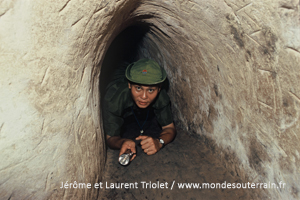
War tunnels
The most famous examples of war tunnels are located in Southern Vietnam. In the region of Saigon, there is an impressive network of tunnels dug mainly during the Vietnam War. Around Cu-Chi and in the Iron Triangle, there might have been up to 300 km of tunnels with a capacity of 16 000 people. The corridors of Cu-Chi tunnels are very low (0,6 to 1,1 m high) and narrow (0,5 to 0,7 m wide), each section is several hundred meters long. They often change direction, are divided into numerous branches and arranged on 2 or 3 levels. Hatches carefully disguised in the ground of the forest closed the entrances of the tunnels. This tunnel network was connected externally to trenches and firing positions. The long and narrow tunnels also lead to half-buried rooms in which Viet Cong spent most of the time. They were used as kitchens, sleeping-rooms, meeting-rooms, infirmaries or operating rooms. At the lower level, the corridors lead to underground rooms, these smaller and safer rooms were used as bomb shelters and contained food, weapons and ammunition storages.
In Southern Lebanon, the galleries and bunkers dug by the Hezbollah seem to be a contemporary variant of Vietnam war tunnels. In July 2006, the Israeli Army entered Southern Lebanon. Despite air power and the great technological superiority of Tsahal, well protected inside the cavities and moving secretly thanks to the tunnels, Hezbollah fighters effectively resisted the enemy. Israeli forces lost 120 soldiers and around 60 tanks.
Inside war tunnels, thanks to the corridors, the half-buried and underground rooms, fighters can escape aerial surveillance and protect themselves against repeated and destructive bombings. The long corridors of war tunnels allow fighters to escape mopping-up operations, to move secretly and to counter attack where they were not expected. For this reason, the tunnels are connected with trenches and firing positions. Because of their direct involvement in the fight, war tunnels are different from underground refuges.
Photo Library “Tunnels of Vietnam”
|